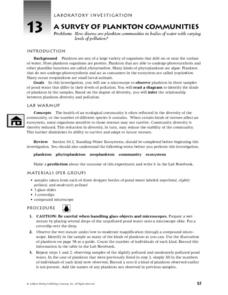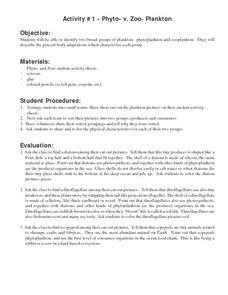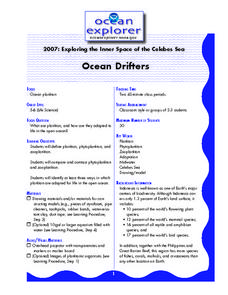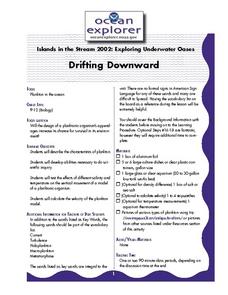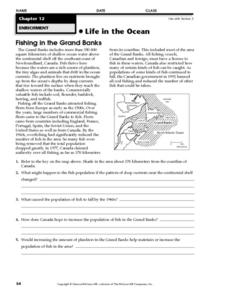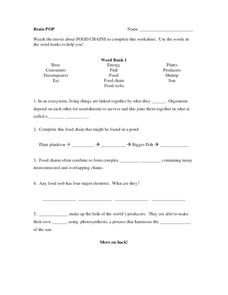Curated OER
A Survey of Plankton Communities
In this biology worksheet, students identify and define the vocabulary terms listed and make a prediction about the outcomes of the experiment. Then they complete the chart of the observations of the plankton diversity in drops of pond...
Curated OER
Plankton
Learners explore how to collect plankton and use microscopes to observe and identify it. They collect the plankton sample and classify the various components of the plankton. Students identify organisms in the plankton and draw...
Curated OER
Phyto- v. Zoo- Plankton
Learners identify two broad groups of plankton: phytoplankton and zoo plankton. They describe the general body adaptations which characterize each group. They discuss and write about what it would be like to be carried around by the...
Curated OER
No Escape
Via four student handouts, marine biology learners examine the topography and circulation cell of the Fieberilng guyot. Then they examine the number of individual hydroids counted at each depth. Pupils use the information to relate water...
Curated OER
Great Blobs of Jelly!
Students explain how zoo-plankton have an impact on the global process. In this ocean zoo-plankton lesson students calculate carbon flux and plankton densities.
Curated OER
Ocean Drifters
Students define terms, and identify three ways in which plankton are adapted for life in the open ocean. In this ocean drift lesson students design a planktonic organism.
Curated OER
Drifting Downward
Learners study the effects of different salients and temperatures on vertical movement of an organism. For this experimental lesson students design different shapes of foil to simulate drifting planktonic organisms.
Curated OER
Plankton
Students research phytoplankton and zooplankton. In this food chain lesson, students read This is the Sea That Feeds Us and discuss plankton, food chains, and webs. Students define phytoplankton and compare them to land plants. Students...
Curated OER
Plankton
Students explore the attributes of plankton. In this plankton lesson, students read This is the Sea That Feeds Us and discuss food chains. Students discover the differences between phytoplankton and zooplankton as they examine the...
Curated OER
Temporary Zooplankton Mix and Match
In this plankton worksheet, students draw a line between the larvae and the adult. Students write the name of each adult animal under the 8 drawings.
Curated OER
Life in the Ocean
In this ocean worksheet, students review the different life forms that can be found in the ocean and how these organisms are connected to each other. This worksheet has 12 short answer questions.
Curated OER
Fishing in the Grand Banks
In this fishing worksheet, students read about the fishing trends off of Newfoundland, Canada and how fishing has effected fish populations. Students complete 5 short answer questions based on the reading.
Curated OER
Food Chains
In this chemistry worksheet, students watch a movie about food chains and use it to respond to each of the questions stated. They use the list of works in the word banks to assist them in matching the correct term to its description.
Curated OER
Collecting Plankton
In this science worksheet, students learn facts about plankton by reading two pages of factual information. Students read about the different kinds of plankton and how it is classified. Detailed drawings are included. There are no...
Curated OER
Pond Water Survey
In this pond ecosystem learning exercise, learners observe different species of plankton found in a pond water sample. They draw pictures of 5 specimens then describe them in detail.
Curated OER
Pond Water
Students explore a creek environment. They make observations, identify the living and nonliving factors in the environment and collect a plankton sample to take back to the classroom. In addition, they look at plankton under a microscope.
Science Buddies
Science Buddies: Primary Productivity and Plankton
The oceans contain both the earth's largest and smallest organisms. Interestingly they share a delicate relationship linked together by what they eat. The largest of the ocean's inhabitants, the Blue Whale, eats very small plankton,...
Other
Rutgers: c.o.o.l. Class: Physics Project: Plankton and Ocean Current
This c.o.o.l. Project focuses on tiny sea plankton and how they move in the oceans. Follow the scientific process outlined on the left, calculate and collect data to form your own predictions.
Other
The Marine Science Institute
The Marine Science Institute offers various general information about the San Francisco bay and its ecology.
CK-12 Foundation
Ck 12: Episd: Aquatic Organisms
[Free Registration/Login may be required to access all resource tools.] Study the research of aquatic organisms and how they move and live. Be prepared to give examples of the types of these wet organisms.
Texas A&M University
Ocean World: Bringing the Ocean to the Classroom
Online resource for students and teachers to see information on icebergs, fisheries, coral reefs, waves, currents and more. Provides teachers with learning activities. Has its own ask-an-expert site (Ask Dr. Bob), and provides real-time...
NASA
Nasa Earth Observatory: What Are Phytoplankton? Fact Sheet
Learn about the characteristics of and different species of phytoplankton. Topics highlighted in this article include photosynthesis, global change, and the marine food chain.
TED Talks
Ted: Ted Ed: How Life Begins in the Deep Ocean
Educator, Tierney Thys, relates the story of a sea urchin's different phases of development while revealing a beautiful tale of fertilization, development and growth in the deep ocean. [6:02]
Science Education Resource Center at Carleton College
Serc: Climate Analysis Using Planktonic Foraminifera
This student activity demonstrates how foraminifera, a species of plankton, can be used to analyze climate.


